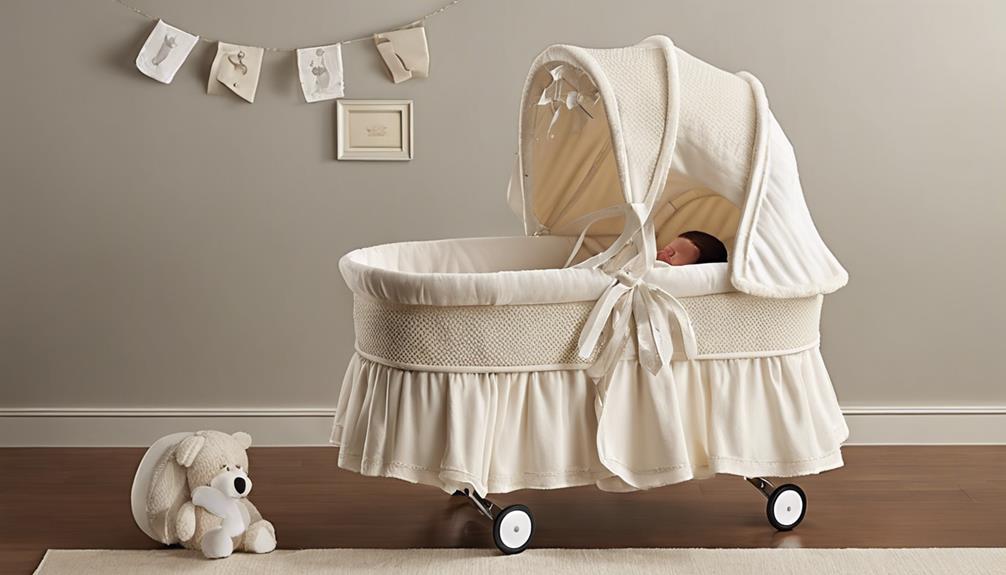Alright, let's tackle the challenge of getting your newborn to drift off peacefully in their bassinet at night.
We all know the struggle of those sleepless nights. But fear not, because we've got some practical tips up our sleeves that might just be the game-changer you've been looking for.
From establishing a cozy sleep environment to fine-tuning a soothing bedtime routine, these strategies are designed to help your little one snooze soundly.
So, are you ready to discover the secrets to a more restful night for both you and your baby?
Key Takeaways
- Maintain a cozy sleep environment between 68-72°F with blackout curtains.
- Implement a soothing bedtime routine with consistent activities and calming cues.
- Swaddle your baby securely in a firm, breathable swaddle to mimic the womb.
- Manage startle reflex by swaddling to prevent disturbances and offering soothing techniques.
Establishing a Comfortable Sleep Environment
To guarantee ideal sleep conditions for your newborn in the bassinet at night, maintain a room temperature between 68-72°F and use blackout curtains to block out excess light. These factors play a vital role in creating a soothing environment for your baby's sleep. The right temperature ensures your little one is neither too hot nor too cold, promoting a comfortable and restful sleep experience. Blackout curtains help mimic the darkness of the night, signaling to your newborn that it's time to sleep. Additionally, following safe sleep guidelines by making sure the bassinet mattress is firm and free of loose bedding, blankets, or toys reduces any risks and provides a safe sleeping space for your baby.
The use of white noise machines can further enhance the sleep environment by masking any disruptive sounds and helping your newborn stay asleep. Swaddling can also be a helpful technique to calm your baby, as it mimics the feeling of being in the womb, triggering the calming reflex and promoting better sleep. Paying attention to your baby's sleep cues and placing them on their back to sleep are essential practices to guarantee your newborn's safety and comfort during sleep time.
Implementing a Soothing Bedtime Routine

Let's focus on creating a calming bedtime routine for your newborn.
Consistent activities like a warm bath or gentle massage can help signal bedtime approaching.
Using soothing cues such as dim lights and soft music can aid in winding down for a restful night in the bassinet.
Calm Bedtime Activities
Engaging in calming activities like gentle rocking or singing lullabies before bedtime can help establish a soothing bedtime routine for your newborn. Creating a peaceful environment is key to preparing your baby for sleep. Here are some calming bedtime activities to incorporate into your routine:
- Gentle Rocking: Rocking your baby gently can help them relax and feel secure.
- Singing Lullabies: Softly singing lullabies can have a comforting effect on your little one.
- Dim Lights: Dimming the lights signals to your baby that it's time to wind down.
- Reduce Stimulation: Minimize noise and activity to promote a tranquil atmosphere.
- Gentle Massage: A gentle massage can be soothing and relaxing for your baby before bedtime.
Consistent Sleep Environment
Creating a consistent sleep environment for your newborn involves establishing a soothing bedtime routine that incorporates calming activities such as bath time, gentle massage, and quiet time. These consistent activities signal to your baby that it's time to rest, helping create a soothing atmosphere.
Utilizing calming techniques like gentle rocking, soft music, or reading a bedtime story can enhance the environment for sleep in the bassinet. Dimming the lights, minimizing stimulation, and ensuring a dark and quiet space before bedtime can prepare your baby for a peaceful night's rest.
Maintaining a comfortable room temperature, using familiar sleep cues, and avoiding stimulating activities like screen time can promote a calm setting for your baby to drift off into sleep in the bassinet effectively.
Swaddling Techniques for Better Sleep
When swaddling your newborn for better sleep in a bassinet, assure a snug and secure fit to mimic the womb environment and prevent disruptions caused by the startle reflex. Swaddling not only provides comfort but also aids in SIDS prevention by assuring your baby maintains a safe sleep position on their back.
To make the most of swaddling techniques, consider the following tips:
- Opt for swaddles with Velcro or zipper closures for a secure wrap that stays in place throughout the night.
- Check for any signs of overheating such as sweating or feeling hot to the touch to keep your baby cozy but not too warm.
- Assure the swaddle isn't too tight to allow some movement for your newborn's comfort.
- Fold down the top of the swaddle to create a pocket for your baby's legs to move more naturally.
- Always place your baby in the bassinet on their back to reduce the risk of SIDS and promote safe sleeping habits.
Managing Newborn's Startle Reflex

To help your newborn sleep soundly in the bassinet, understanding and managing your baby's startle reflex is essential for promoting uninterrupted rest. The startle reflex, also known as the Moro reflex, is a common occurrence in newborns that can lead to sudden arm and leg movements, potentially disrupting sleep. Swaddling your baby can be an effective method to prevent the startle reflex from waking them up. By securely wrapping your baby in a swaddle or sleep sack, you can recreate the cozy and secure feeling of the womb, reducing the likelihood of the startle reflex disturbing their sleep. As your baby grows and starts showing signs of rolling over, it may be time to phase out swaddling to prevent any sleep disturbances. Additionally, providing gentle pressure on their chest or offering a pacifier can help soothe the startle reflex and encourage better sleep in the bassinet.
| Method | Description |
|---|---|
| Swaddling | Wrapping your baby snugly in a swaddle or sleep sack to mimic the womb and reduce startle reflex |
| Transitioning | Gradually phasing out of swaddling when your baby begins to roll over |
| Soothing Methods | Applying gentle pressure on your baby's chest or offering a pacifier to calm the startle reflex |
Using White Noise or Sound Machines

Using white noise or sound machines in the nursery can greatly benefit your newborn's sleep by creating a consistent background sound that masks other noises and promotes better rest. These machines are a valuable tool for soothing newborns and establishing a calming sleep environment. Here are some key points to take into account when using white noise or sound machines for your baby:
- White noise can mimic the sounds babies heard in the womb, providing a soothing and familiar environment for sleep.
- Sound machines help drown out sudden noises that might startle a baby awake, aiding in longer and more restful sleep periods.
- Consistent white noise can establish a sleep cue for babies, signaling bedtime and creating a calming sleep routine.
- Research suggests that white noise can improve sleep quality by reducing the time it takes to fall asleep and decreasing the number of awakenings during the night.
- By using white noise or sound machines, you can create a peaceful and conducive atmosphere that promotes better sleep for your newborn.
Ensuring Proper Feeding Schedule

Maintain a consistent feeding schedule to make certain your newborn is well-fed before bedtime. It's important to avoid overfeeding close to bedtime to prevent discomfort and reflux issues during nighttime sleep.
After a feeding session, implementing a soothing bedtime routine can help your newborn relax and prepare for sleep in the bassinet effectively. Consider incorporating the dream feeding technique, which involves feeding your baby without fully waking them, encouraging longer stretches of uninterrupted sleep.
By closely monitoring your baby's feeding cues and adjusting feeding times accordingly, you can make sure that their nutritional needs are met while supporting better sleep patterns. Consistent feeding plays an important role in establishing a healthy sleep routine for your newborn, enhancing their overall well-being and promoting restful nights.
Consistency in Sleep Habits

Establishing a consistent bedtime routine for your newborn can signal that it's time for sleep. Maintaining a regular sleep schedule helps regulate your baby's internal clock, promoting better rest.
Creating a comfortable sleep environment, using the same bassinet, aids in familiarizing your little one with their sleep space.
Bedtime Routine Importance
Creating a consistent bedtime routine for your newborn can greatly aid in signaling that it's time to sleep in the bassinet. By following the same sequence of activities each night, like a bath, feeding, and lullabies, you can create a calming association with bedtime. Consistency in sleep habits helps regulate your newborn's internal clock, promoting better sleep patterns in the bassinet.
A predictable bedtime routine can reduce fussiness and help your newborn switch smoothly to sleep at night. Incorporating soothing activities such as gentle rocking or cuddling before placing your newborn in the bassinet can enhance the bedtime routine.
- Establish a calming bedtime routine
- Maintain consistency in activities
- Promote better sleep patterns
- Reduce fussiness before bedtime
- Include soothing activities like gentle rocking and cuddling
Regular Sleep Schedule
To guarantee your newborn's best sleep in the bassinet at night, it's essential to adhere to a consistent sleep schedule. Establishing a newborn sleep schedule with regular sleep and wake times helps regulate their internal clock, promoting longer and more restful periods of sleep in the bassinet.
Consistency in bedtime routines signals to your baby that it's time to rest, reducing nighttime awakenings and fostering healthy sleep patterns. Following a structured sleep schedule not only aids in self-soothing but also creates a familiar sleep environment that makes your baby feel secure and comfortable in the bassinet.
Comfortable Sleep Environment
For best comfort and improved sleep quality for your newborn in the bassinet, ensuring consistency in sleep habits is key. When creating a comfortable sleep environment, consider these tips:
- Establish a bedtime routine with consistent cues to signal sleep time.
- Maintain a comfortable room temperature between 68-72 degrees Fahrenheit.
- Use swaddling techniques for a cozy and secure feeling.
- Guarantee proper mattress support for your baby's comfort.
- Promote skin-to-skin bonding to enhance the sleep experience.
Conclusion
To sum up, implementing these strategies can help your newborn sleep peacefully in a bassinet at night.
Did you know that on average, newborns need around 16-17 hours of sleep a day?
By creating a comfortable sleep environment, swaddling effectively, and establishing a soothing bedtime routine, you can help your little one get the rest they need for healthy growth and development.
Stick to these tips consistently for a well-rested baby and a happier household.









